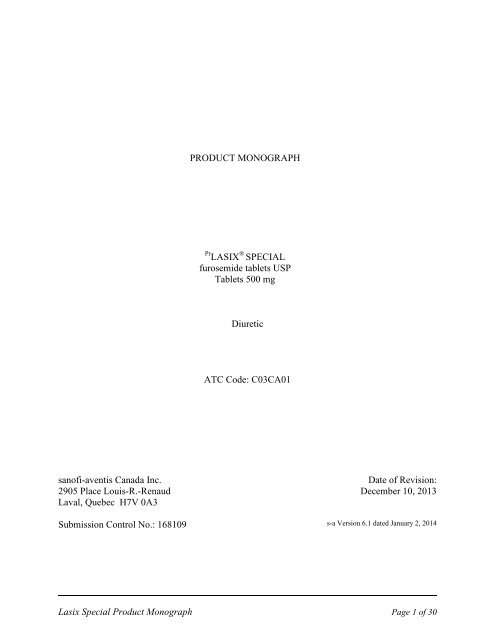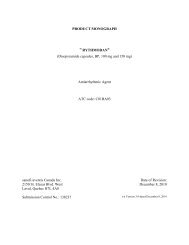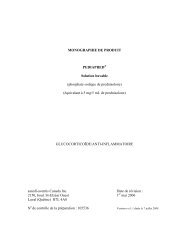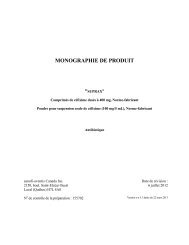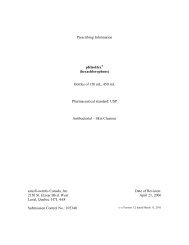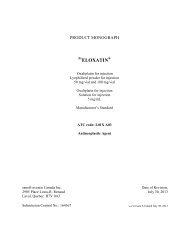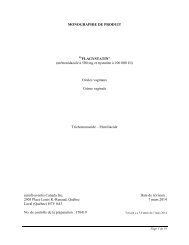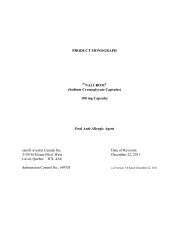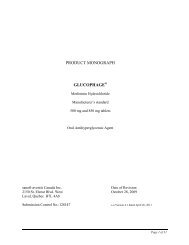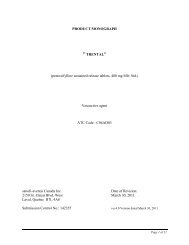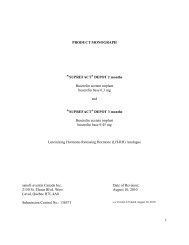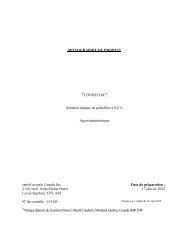Lasix Special (furosemide) - Sanofi Canada
Lasix Special (furosemide) - Sanofi Canada
Lasix Special (furosemide) - Sanofi Canada
You also want an ePaper? Increase the reach of your titles
YUMPU automatically turns print PDFs into web optimized ePapers that Google loves.
PRODUCT MONOGRAPHPr LASIX ® SPECIAL<strong>furosemide</strong> tablets USPTablets 500 mgDiureticATC Code: C03CA01sanofi-aventis <strong>Canada</strong> Inc.2905 Place Louis-R.-RenaudLaval, Quebec H7V 0A3Date of Revision:December 10, 2013Submission Control No.: 168109 s-a Version 6.1 dated January 2, 2014<strong>Lasix</strong> <strong>Special</strong> Product Monograph Page 1 of 30
Table of ContentsPART I: HEALTH PROFESSIONAL INFORMATION ......................................................... 3SUMMARY PRODUCT INFORMATION ................................................................................ 3INDICATIONS AND CLINICAL USE ..................................................................................... 3CONTRAINDICATIONS .......................................................................................................... 4WARNINGS AND PRECAUTIONS ......................................................................................... 4ADVERSE REACTIONS ........................................................................................................... 9DRUG INTERACTIONS ......................................................................................................... 12DOSAGE AND ADMINISTRATION ..................................................................................... 16OVERDOSAGE ....................................................................................................................... 18ACTION AND CLINICAL PHARMACOLOGY ................................................................... 18STORAGE AND STABILITY ................................................................................................. 20DOSAGE FORMS, COMPOSITION AND PACKAGING .................................................... 20PART II: SCIENTIFIC INFORMATION ............................................................................... 21PHARMACEUTICAL INFORMATION ................................................................................. 21CLINICAL TRIALS ................................................................................................................. 22DETAILED PHARMACOLOGY ............................................................................................ 22TOXICOLOGY ........................................................................................................................ 23REFERENCES ......................................................................................................................... 25PART III: CONSUMER INFORMATION.............................................................................. 26<strong>Lasix</strong> <strong>Special</strong> Product Monograph Page 2 of 30
CONTRAINDICATIONSLASIX SPECIAL is contraindicated in:• Patients who are hypersensitive to <strong>furosemide</strong>, sulfonamide-derived drugs, or to anyingredient in the formulation or component of the container. For a complete listing, seethe Dosage Forms, Composition and Packaging section of the product monograph.Patients allergic to sulfonamides (e.g. sulfonamide antibiotics or sulfonylureas) mayshow cross-sensitivity to <strong>furosemide</strong>.• Patients with complete renal shutdown and glomerular filtration rate below 5 mL/min.• PATIENTS WHOSE GLOMERULAR FILTRATION RATE IS ABOVE 20 mL/min.IN SUCH CASES, IT MIGHT CAUSE EXTREMELY SEVERE WATER ANDELECTROLYTE LOSSES.• Patients with hepatic cirrhosis, patients with renal failure due to poisoning withnephrotoxic or hepatotoxic substances and patients with renal failure accompanied byhepatic coma and precoma (see WARNINGS AND PRECAUTIONS and ADVERSEREACTIONS sections).• Severe hyponatremia, hypokalemia, hypovolemia, dehydration or hypotension must beregarded as contraindications until serum electrolytes and fluid balance and bloodpressure have been restored to normal levels (see WARNINGS AND PRECAUTIONSand ADVERSE REACTIONS sections).• As <strong>furosemide</strong> may be capable of displacing bilirubin from albumin at least "in vitro", itshould not be administered to jaundiced newborn infants or to infants suffering fromdiseases (e.g. Rh incompatibility, familial non-hemolytic jaundice, etc.) with thepotential of causing hyperbilirubinemia and possibly kernicterus.• Women must not breast-feed if they are treated with <strong>furosemide</strong> (see WARNINGSAND PRECAUTIONS section).WARNINGS AND PRECAUTIONSGeneralLASIX SPECIAL IS A POTENT DIURETIC WHICH IF GIVEN IN EXCESSIVEAMOUNTS CAN LEAD TO A PROFOUND DIURESIS WITH WATER ANDELECTROLYTE DEPLETION. THEREFORE, CAREFUL MEDICAL SUPERVISION ISREQUIRED, AND DOSE AND DOSE SCHEDULE HAVE TO BE ADJUSTED TO THEINDIVIDUAL PATIENT'S NEEDS (SEE DOSAGE AND ADMINISTRATION).<strong>Lasix</strong> <strong>Special</strong> Product Monograph Page 4 of 30
Carcinogenesis and MutagenesisCarcinogenicity: Furosemide in the approximate amount of 200 mg/kg body weight daily wasadministered to female mice and rats over a 2-year period with their diet. An increasedincidence of mammary adenocarcinoma was noted in the mice, but not in the rats. These tumorsoccurred with a positive trend, and the incidence in the high dose group was increasedcompared to the control, in addition, the high-dose rate was about five fold over the historicalrate. These tumors are considered to be associated with <strong>furosemide</strong> administration. This dose isconsiderably greater than the therapeutic dose administered in human patients.In a carcinogenicity study, rats were administered <strong>furosemide</strong> in daily doses of 15 and 30 mg/kgbody weight. Male rats in the 15 mg/kg-dose category, but not in the 30 mg/kg-dose category,showed a marginal increase in uncommon tumours.Mutagenicity: In in-vitro tests on bacteria and mammalian cells, both positive and negativeresults have been obtained. Induction of gene and chromosome mutations, however, has beenobserved only where <strong>furosemide</strong> reached cytotoxic concentrations.Ear/Nose/ThroatCases of tinnitus and reversible deafness have been reported. There have also been some reportsof cases, the majority in children undergoing renal transplantation, in which permanent deafnesshas occurred. In these latter cases, the onset of deafness was usually insidious and graduallyprogressive up to 6 months after <strong>furosemide</strong> therapy. (The 500 mg <strong>furosemide</strong> tablet is foradults only). Hearing impairment is more likely to occur in patients with hypoproteinaemia orseverely reduced renal function, or in patients who are also receiving drugs known to beototoxic. Since this may lead to irreversible damage, these drugs must only be used with<strong>furosemide</strong> if there are compelling medical reasons.Endocrine and MetabolismIncreases in blood glucose and alterations in glucose tolerance tests with abnormalities of thefasting and two-hour postprandial blood sugar levels have been observed. Rare cases ofprecipitation of diabetes mellitus have been reported.Asymptomatic hyperuricemia can occur and a gout attack may rarely be precipitated.Peri-Operative ConsiderationsSulfonamide diuretics have been reported to decrease arterial responsiveness to pressor aminesand to enhance the effect of tubocurarine or curare-type muscle relaxants. Great caution shouldbe exercised in administering curare or its derivatives to patients undergoing therapy withLASIX SPECIAL and it is advisable to discontinue LASIX SPECIAL for one week prior to anyelective surgery.<strong>Lasix</strong> <strong>Special</strong> Product Monograph Page 6 of 30
<strong>Special</strong> PopulationsPregnant WomenThe teratogenic and embryotoxic potential of <strong>furosemide</strong> in humans is unknown. The drugshould not be used in pregnant women or in women of childbearing potential unless in theopinion of the attending physician the benefits to the patient outweigh the possible risk to thefoetus.Reproductive and teratological studies have been performed in mice, rats, rabbits, cats, dogsand monkeys. With the exception of mice and rabbits, no abnormalities attributed to <strong>furosemide</strong>were detected. Furosemide caused unexplained maternal deaths and abortions in the rabbit at adaily dose of 50 mg/kg (approximately three times the maximum recommended human dailydose of 1000 mg orally) when administered between days 12 to 17 of gestation. In anotherstudy in rabbits, a dose of 25 mg/kg caused maternal deaths and abortions. In a third study,none of the pregnant rabbits survived a dose of 100 mg/kg. Data from the above studies indicatefoetal lethality which can precede maternal deaths.The results of a mouse study and one of the three rabbit studies also showed an increasedincidence of distention of the renal pelvis and, in some cases, of the ureters in foetuses derivedfrom treated dams as compared to the incidence of foetuses from the control group.Treatment during pregnancy requires monitoring of fetal growth.Nursing WomenIt should be noted that diuretics may partially inhibit lactation and that LASIX SPECIAL passesinto the breast milk. Women must not breast-feed during treatment with <strong>furosemide</strong> (seeCONTRAINDICATIONS section).Pediatrics (newborn-15 years)LASIX SPECIAL is not recommended for pediatric use.LASIX SPECIAL may lower serum calcium levels, and rare cases of tetany have been reported.In premature infants LASIX may precipitate nephrocalcinosis/nephrolithiasis.When administered to premature infants with respiratory distress syndrome in the first fewweeks of life, diuretic treatment with LASIX may accentuate the risk of a patent ductusarteriosus.Geriatrics (> 61 years of age)Excessive diuresis induced by LASIX SPECIAL may result in dehydration and reduction ofblood volume, with circulatory collapse and with the possibility of vascular thrombosis andembolism particularly in elderly patients. LASIX SPECIAL may cause electrolyte depletion.<strong>Lasix</strong> <strong>Special</strong> Product Monograph Page 7 of 30
Furosemide binding to albumin may be reduced in elderly patients.The drug is known to be substantially excreted unchanged by the kidney, and the risk of toxicreactions to this drug may be greater in patients with impaired renal function. Because elderlypatients are more likely to have decreased renal functions, care should be taken in doseselection and may be useful to monitor renal function.In general dose selection for the elderly patients should be cautious, usually starting at the lowend of dosage range, reflecting the greater frequency of decreased hepatic, renal or cardiacfunction, and the concomitant disease or other drug therapy.Monitoring and Laboratory TestsFrequent serum electrolyte, creatinine and CO2 content determinations should be performedduring the first few months of therapy and periodically thereafter. It is essential to replaceelectrolyte losses and to maintain fluid balance so as to avoid any risk of electrolyte depletion(hyponatremia, hypochloremia, hypokalemia, hypomagnesemia or hypocalcemia),hypovolemia, or hypotension.Checks on urine and blood glucose should be made at regular intervals especially in diabeticsand in those suspected of latent diabetes when receiving LASIX SPECIAL. Increases in bloodglucose and alterations in glucose tolerance tests with abnormalities of the fasting and two-hourpostprandial blood sugar levels have been observed.Frequent BUN determinations during the first few months of therapy and periodicallythereafter, as well as regular observations for possible occurence of blood dyscrasias, liverdamage or idiosyncratic reactions are advisable.Particularly careful monitoring is necessary in:- patients with hypoproteinaemia. Cautious dose titration is required.- patients with hypotension- patients who would be at particular risk from a pronounced fall in blood pressure (e.g.patients with significant stenoses of the coronary arteries or of the blood vesselssupplying the brain).- patients with hepatorenal syndrome.- patients with latent and manifest diabetes mellitus- patients with goutOccupational HazardsLASIX SPECIAL may lower the state of patient alertness and/or reactivity particularly at thestart of treatment as a result of a reduction in blood pressure and of other adverse reactions (seeADVERSE REACTIONS section).<strong>Lasix</strong> <strong>Special</strong> Product Monograph Page 8 of 30
ADVERSE REACTIONSClinical Trial Adverse Drug ReactionsNo data available.Post-Market Adverse Drug ReactionsAdverse reactions are categorized below by body system.Blood and lymphatic system disordersAnemia, eosinophilia, leukopenia and thrombocytopenia (with purpura) have occurred, as wellas agranulocytosis, aplastic anemia and hemolytic anemia.Ear and Labyrinth disordersCases of tinnitus and sometimes irreversible deafness have been reported. There have also beensome reports of cases, the majority in children undergoing renal transplantation, in whichpermanent deafness has occurred. In these latter cases, the onset of deafness is usually insidiousand gradually progressive up to 6 months after <strong>furosemide</strong> therapy. Hearing disorder is morelikely to occur in patients with hypoproteinaemia or severely reduced renal function who arealso receiving drugs known to be ototoxic.Vertigo has been reported.Eye disordersXanthopsia and blurred vision have been reported.Gastrointestinal disordersAcute pancreatitis, oral and gastric burning, diarrhea, nausea, vomiting and constipation havebeen reported. Rare occurences of sweet taste have been reported.Hepatobiliary disordersJaundice (intrahepatic cholestatic jaundice) and cholestasis have been reported.Immune system disordersHypersensitivity reactions to <strong>furosemide</strong> also include photosensitivity, paresthesia and fever.Systemic hypersensitivity reactions include vasculitis and necrotizing angiitis.Severe anaphylactic or anaphylactoid reactions (e.g. with shock) occur rarely.<strong>Lasix</strong> <strong>Special</strong> Product Monograph Page 9 of 30
InvestigationsIncrease in liver transaminases has been reported.Transient elevations of BUN have been observed, especially in patients with renalinsufficiency.As with other diuretics, there may be an increase in serum creatinine, uric acid (this may lead togout attack in predisposed patients), blood urea, cholesterol and triglyceride levels during<strong>furosemide</strong> treatment.Metabolism and nutrition disordersElectrolyte depletion has occurred during therapy with LASIX SPECIAL, especially in patientsreceiving higher doses with a restricted salt intake. Electrolyte depletion(hyponatremia,hypochloremia, hypokalaemia, hypocalcemia and hypomagnesemia) manifests itself byadverse reactions attributed to various body systems: weakness, dizziness, drowsiness, polyuria,polydipsia, orthostatic hypotension, lethargy, sweating, bladder spasms, anorexia, vomiting,mental confusion, meteorism, thirst, headache, muscle cramp, muscle weakness, tetany anddisorder of cardiac rhythm (see WARNINGS AND PRECAUTIONS section).The development of electrolyte disturbances (including symptomatic) is influenced by factorssuch as underlying diseases (e.g. liver cirrhosis, cardiac failure), concomitant medication andnutrition.Cases of Pseudo-Bartter syndrome (hypochloremia, hypokalaemia, alkalosis, normal to lowblood pressures, and elevated plasma renin and aldosterone) have been reported in the contextof misuse and/or long-term use of <strong>furosemide</strong>.Treatment with LASIX SPECIAL has occasionally caused some deterioration of metaboliccontrol in cases of manifest diabetes, or has made latent diabetes manifest.Metabolic alkalosis may develop in the form of a gradually increasing electrolyte deficit or, e.g.where higher <strong>furosemide</strong> doses are administered to patients with normal renal function, acutesevere electrolyte losses.Pre-existing metabolic alkalosis (e.g. in decompensated cirrhosis of the liver) may beaggravated.In extreme cases, hypovolemia may lead to dehydration, circulatory collapse,hemoconcentration and thrombophilia. Thrombophlebitis and emboli have been reported.Nervous system disordersAt the commencement of treatment, excessive diuresis may give rise, especially in elderlypatients, to a feeling of pressure in the head, dizziness.<strong>Lasix</strong> <strong>Special</strong> Product Monograph Page 10 of 30
Paresthesia has been reported.Hepatic encephalopathy in patients with hepatocellular insufficiency has been reported.Renal and urinary disordersSymptoms of obstructed micturition (e.g. in hydronephrosis, prostatic hypertrophy,ureterostenosis) may become manifest or may be aggravated during medication with diuretics.Interstitial nephritis has been reported.Increased production of urine may provoke or aggravate complaints in patients with anobstruction of urinary outflow. Thus, acute retention of urine with possible secondarycomplications may occur. Increases in urine sodium and chloride have also been reported.There have been some reported cases of renal failure.In premature infants LASIX may precipitate nephrocalcinosis/nephrolithiasis.Skin and subcutaneous tissue disordersVarious forms of dermatitis (e.g. dermatitis bullous), including urticaria, erythema multiforme,pemphigoid, Stevens-Johnson syndrome, toxic epidermal necrolysis, exfoliative dermatitis,pruritus, epidermolysis bullosa, AGEP (acute generalized exanthematous pustolosis) andDRESS (Drug Rash with Eosinophilia and Systemic Symptoms) have occurred.Dermatologic reactions to <strong>furosemide</strong> also include purpura and rash.Vascular disordersToo vigorous diuresis may induce orthostatic hypotension or acute hypotensive episodes, whichmay cause signs and symptoms such as impairment of concentration and reactions,lightheadedness or orthostatic intolerance. There have been some reported cases of thrombosis.When administered to premature infants with respiratory distress syndrome in the first fewweeks of life, diuretic treatment with LASIX may accentuate the risk of a patent ductusarteriosus.<strong>Lasix</strong> <strong>Special</strong> Product Monograph Page 11 of 30
DRUG INTERACTIONSOverviewSulfonamide diuretics have been reported to decrease arterial responsiveness to pressor aminesand to enhance the effect of tubocurarine or curare-type muscle relaxants (see WARNINGSAND PRECAUTIONS – Peri-Operative Considerations section).In case of concomitant abuse of laxatives, the risk of an increased potassium loss should beconsidered.Glucocorticoids, carbenoxolone and licorice may also increase potassium loss.Administration of LASIX SPECIAL to diabetic patients may result in possible decrease ofdiabetic control. Dosage adjustments of the anti-diabetic agent may be needed.Hearing impairment is more likely to occur in patients who are also receiving drugs known tobe ototoxic (e.g. aminoglycosides antibiotics, ethacrynic acid and cisplatin) (see WARNINGSAND PRECAUTIONS section).In edematous hypertensive patients being treated with antihypertensive agents, care should betaken to reduce the dose of these drugs when LASIX SPECIAL is administered, since LASIXSPECIAL potentiates their hypotensive effect.Non-steroidal anti-inflammatory drugs (e.g. indomethacin, acetyl-salicylic acid) may attenuatethe effect of LASIX SPECIAL and may cause renal failure in case of pre-existing hypovolemia.<strong>Lasix</strong> <strong>Special</strong> Product Monograph Page 12 of 30
Drug-Drug InteractionsThe drug interactions discussed in this section are based on either drug interaction casereports, or studies, or potential interactions due to the expected magnitude and seriousness ofthe interaction (i.e., those identified as contraindicated).Established or Predicted Drug-Drug InteractionsProper Name Ref Effect Clinical CommentsAnticonvulsantsCarbamazepinePhenobarbitalPhenytoinAntidiabeticsAntidiabeticsAntihypertensive AgentsACE inhibitorsAngiotensin II receptor antagonistsCephalosporinsTTCTCT↓ <strong>furosemide</strong>diuretic effect↓ antidiabeticdrug effect↓ blood pressureand renalfunction↓ blood pressureand renalfunctionCephalosporins T ↓ renal functionChloral HydrateChloral Hydrate C —Anticonvulsant drugs (phenytoin,carbamazepine, phenobarbital), which, like<strong>furosemide</strong>, undergo significant renal tubularsecretion, may also attenuate the effect of<strong>furosemide</strong>.The effects of antidiabetic drugs may bereduced.Especially in combination with ACE inhibitors,a marked hypotension may be seen sometimesprogressing to shock. The concomitantadministration of LASIX SPECIAL with ACEinhibitorsmay lead to deterioration in renalfunction and, in isolated cases, to acute renalfailure. Consideration must be given tointerrupting the administration of <strong>furosemide</strong>temporarily or at least reducing the dose of<strong>furosemide</strong> for three days before startingtreatment with, or increasing the dose of, anACE inhibitor.Especially in combination with angiotensin IIreceptor antagonists, a marked hypotensionmay be seen sometimes progressing to shock.The concomitant administration of LASIXSPECIAL with angiotensin II receptorantagonists may lead to deterioration in renalfunction and, in isolated cases, to acute renalfailure. Consideration must be given tointerrupting the administration of <strong>furosemide</strong>temporarily or at least reducing the dose of<strong>furosemide</strong> for three days before startingtreatment with, or increasing the dose of, anangiotensin II receptor antagonist.Impairment of renal function may develop inpatients receiving concurrent treatment with<strong>furosemide</strong> and high doses of certaincephalosporins.In isolated cases intravenous administration of<strong>furosemide</strong> within 24 hours of taking chloral<strong>Lasix</strong> <strong>Special</strong> Product Monograph Page 13 of 30
ChlorothiazidesProper Name Ref Effect Clinical Commentshydrate may lead to flushing, sweating attacks,restlessness, nausea, increase in blood pressureand tachycardia. Use of <strong>furosemide</strong>concomitantly with chloral hydrate is thereforenot recommended.Chlorothiazides T —CisplatinCisplatinCyclosporineT↑ nephrotoxicity↑ ototoxicityCyclosporine CT —Digitalis GlycosidesDigitalis GlycosidesLithiumLithiumMethotrexateMethotrexateNephrotoxic DrugsTTT↓ potassiumplasmaconcentration↑ lithium plasmaconcentration↓ <strong>furosemide</strong>diuretic effectNephrotoxic Drugs T ↑ nephrotoxicityNon-Steroidal Anti-InflammatoryDrugs (NSAIDs)IndomethacinCT↓ <strong>furosemide</strong>diuretic effectThe concurrent use of LASIX SPECIAL withchlorothiazide has been reported to decreasehypercalciuria and to dissolve some calculi.Nephrotoxicity of cisplatin may be enhanced if<strong>furosemide</strong> is not given in low doses and withpositive fluid balance when used to achieveforced diuresis during cisplatin treatment. Thereis also a risk of ototoxic effects if cisplatin and<strong>furosemide</strong> are given concomitantly.Concomitant use of cyclosporine A and<strong>furosemide</strong> is associated with increased risk ofgouty arthritis secondary to <strong>furosemide</strong>-inducedhyperurecemia and cyclosporine impairment ofrenal urate excretion.Some electrolyte disturbances (e.g.hypokalemia, hypomagnesemia) may increasethe toxicity of certain other drugs (e.g. digitalispreparations and drugs inducing QT intervalprolongation syndrome). Particular caution withpotassium levels is necessary when the patientis on digitalis glycosides. Potassiumsupplementation, diminution in dose, ordiscontinuation of LASIX SPECIAL therapymay be required (see WARNINGS ANDPRECAUTIONS).Renal clearance of lithium is decreased inpatients receiving LASIX SPECIAL, resultingin increased risk of cardiotoxic and neurotoxiceffects of lithium. Therefore, it is recommendedthat lithium levels be carefully monitored inpatients receiving this combination.Methotrexate, which like <strong>furosemide</strong>,undergoes significant renal tubular secretion,may also attenuate the effect of <strong>furosemide</strong>.The harmful effects of nephrotoxic drugs on thekidney may be increased.Clinical studies have shown that theadministration of indomethacin can reduce the<strong>Lasix</strong> <strong>Special</strong> Product Monograph Page 14 of 30
Proper Name Ref Effect Clinical Commentsnatriuretic and anti-hypertensive effect ofLASIX SPECIAL in some patients. Thisresponse has been attributed to inhibition ofprostaglandin synthesis by indomethacin.Therefore, when indomethacin is added to thetreatment of a patient receiving LASIXSPECIAL, or LASIX SPECIAL is added to thetreatment of a patient receiving indomethacin,the patient should be closely observed todetermine if the desired effect of LASIXSPECIAL is obtained. Indomethacin blocks theLASIX SPECIAL-induced increase in plasmareninactivity. This fact should be kept in mindwhen evaluating plasma-renin activity inhypertensive patients.Potassium-depleting SteroidsPotassium-depleting SteroidsProbenecidProbenecidRadiocontrast AgentsRadiocontrast AgentsRisperidoneTTCT↓ potassiumplasmaconcentration↓ <strong>furosemide</strong>diuretic effect↑ radiocontrastnephropathyRisperidone CT —SalicylatesSalicylatesT↑ salicylatetoxicitySome electrolyte disturbances (e.g.hypokalemia, hypomagnesemia) may increasethe toxicity of certain other drugs (e.g. digitalispreparations and drugs inducing QT intervalprolongation syndrome). Particular caution withpotassium levels is necessary when the patientis on potassium-depleting steroids. Potassiumsupplementation, diminution in dose, ordiscontinuation of LASIX SPECIAL therapymay be required (see WARNINGS ANDPRECAUTIONS).Probenecid, which like <strong>furosemide</strong>, undergoessignificant renal tubular secretion, may alsoattenuate the effect of <strong>furosemide</strong>.Patients who were at high risk for radiocontrastnephropathy treated with <strong>furosemide</strong>experienced a higher incidence of deteriorationin renal function after receiving radiocontrastcompared to high-risk patients who receivedonly intravenous hydration prior to receivingradiocontrast.Caution should be exercised and the risks andbenefits of the combination or co-treatmentwith <strong>furosemide</strong> or with other potent diureticsshould be considered prior to the decision touse. See PRECAUTIONS section, regardingincreased mortality in elderly patients withdementia concomitantly receiving risperidone.Patients receiving high doses of salicylates inconjunction with LASIX SPECIAL mayexperience salicylate toxicity at lower dosesbecause of competition for renal excretory sites.<strong>Lasix</strong> <strong>Special</strong> Product Monograph Page 15 of 30
Proper Name Ref Effect Clinical CommentsSucralfateSucralfateT↓ <strong>furosemide</strong>absorptionTheophyllineTheophyllineT↑ theophyllineeffectLegend: C= Case Study; CT= Clinical Trial; T= TheoreticalInteractions with other drugs have not been established.Drug-Food InteractionsInteractions with food have not been established.Drug-Herb InteractionsInteractions with herbal product have not been established.Drug-Laboratory InteractionsInteractions with laboratory tests have not been established.Concurrent administration of LASIX SPECIALand sucralfate should be avoided, as sucralfatereduces the absorption of <strong>furosemide</strong> from theintestine and hence weakens its effect.The effects of theophylline may be increased.DOSAGE AND ADMINISTRATIONDosing ConsiderationsLASIX SPECIAL is to be used under strict medical supervision in a hospital setting.THE HIGH-DOSAGE FORMULATION LASIX SPECIAL IS INTENDED EXCLUSIVELYFOR SELECTED PATIENTS WITH SEVERELY IMPAIRED GLOMERULARFILTRATION (GFR of less than 20 mL/min. but greater than 5 mL/min.), WHO HAVE NOTRESPONDED TO CONVENTIONAL DOSES OF LASIX (SEE INDICATIONS ANDCLINICAL USE).WHEN LASIX SPECIAL IS USED IN HIGH DOSES CAREFUL ATTENTION MUST BEPAID TO THE FOLLOWING POINTS:● IF THE PATIENT IS IN SHOCK, HYPOVOLEMIA AND HYPOTENSION MUST BECORRECTED BY APPROPRIATE MEASURES BEFORE STARTING THERAPY.● ANY SERIOUS ABNORMALITIES OF SERUM ELECTROLYTES OR ACID-BASEBALANCE MUST BE CORRECTED BEFOREHAND.<strong>Lasix</strong> <strong>Special</strong> Product Monograph Page 16 of 30
● WHEN TREATING PATIENTS WITH CONDITIONS LIKELY TO INTERFERE WITHMICTURITION, SUCH AS PROSTATIC HYPERTROPHY OR DISTURBEDCONSCIOUSNESS, IT IS ABSOLUTELY ESSENTIAL TO ENSURE FREE URINARYDRAINAGE.● BECAUSE OF THE WIDE AND UNPREDICTABLE INDIVIDUAL VARIATIONS INRESPONSIVENESS IT IS IMPORTANT TO ADJUST DOSAGE AND ROUTE OFADMINISTRATION TO INDIVIDUAL NEEDS.● ONCE THE DESIRED RISE IN URINARY OUTPUT HAS BEGUN, EXACT BALANCEOF WATER INTAKE AND WATER OUTPUT MUST BE MAINTAINEDTHROUGHOUT THE COURSE OF TREATMENT, SO AS TO AVOIDHYPOVOLEMIA OR HYPOTENSION. CAREFUL ELECTROLYTE REPLACEMENTIS ALSO NECESSARY.THE DOSAGE OF HIGH STRENGTH LASIX SPECIAL GIVEN BELOW IS FOR ADULTSONLY. THE ADMINISTRATION OF LARGE DOSES OF FUROSEMIDE IN CHILDRENHAS BEEN ASSOCIATED WITH PERMANENT DEAFNESS (See WARNINGS ANDPRECAUTIONS).Recommended Dose and Dosage AdjustmentInitial dose: The dose of <strong>furosemide</strong> which has been found to produce an effective diuresiswhen given intravenously is used as the initial dose.For the initial intravenous dose, follow the manufacturer’s dosage recommendations for theadministration of intravenous <strong>furosemide</strong> as stated in the appropriate Product Monograph.Additional dose: Should the initial dose fail to produce an adequate increase (at least 40-50 mL)in urinary output within 4-6 hours, the dose may be raised by 250 to 500 mg at a time.For selected patients with advanced chronic renal failure, diuretic therapy may be started withLASIX orally. If conventional doses (80 to 160 mg orally) fail to produce an adequate diuresis,a single dose of 250 mg is given as a starting dose. If a satisfactory diuresis does not ensuewithin 4-6 hours, the initial dose may be doubled to 500 mg.The criterion of optimal dosage is a urinary output of at least 2.5 litres per day.A maximum daily dose of 1000 mg should not be exceeded.<strong>Lasix</strong> <strong>Special</strong> Product Monograph Page 17 of 30
OVERDOSAGESymptomsDehydration, electrolyte depletion and hypotension may be caused by overdosage or accidentalingestion. In cirrhotic patients, overdosage might precipitate hepatic coma.The clinical picture in acute or chronic overdose depends primarily on the extent andconsequences of electrolyte and fluide loss, e.g. hypovolemia, dehydration, hemoconcentration,cardiac arrhythmias (including A-V block and ventricular fibrillation). Symptoms of thesedisturbances include severe hypotension (progressing to shock), acute renal failure, thrombosis,delirious states, flaccid paralysis, apathy and confusion.For management of a suspected drug overdose, contact your regional Poison Control Centre.TreatmentThe drug should be discontinued and appropriate corrective treatment applied: replacement ofexcessive fluid and electrolyte losses; serum electrolytes, carbon dioxide level and bloodpressure should be determined frequently. Adequate drainage must be assured in patients withurinary bladder outlet obstruction (such as prostatic hypertrophy).No specific antidote to <strong>furosemide</strong> is known. If ingestion has only just taken place, attemptsmay be made to limit further systemic absorption of the active ingredient by measures such asgastric lavage or those designed to reduce absorption (e.g. activated charcoal).ACTION AND CLINICAL PHARMACOLOGYMechanism of ActionAnimal experiments using stop-flow and micropuncture techniques have demonstrated that<strong>furosemide</strong> inhibits sodium reabsorption in the ascending limb of Henle's loop as well as inboth proximal and distal tubules. The action of LASIX SPECIAL on the distal tubule isindependent of any inhibitory effect on carbonic anhydrase or aldosterone.Furosemide may promote diuresis in cases which have previously proved resistant to otherdiuretics.PharmacodynamicsA continuous infusion of <strong>furosemide</strong> is more effective than repetitive bolus injections.Moreover, above a certain bolus dose of the drug there is no significant increase in effect.The effect of <strong>furosemide</strong> is reduced if there is lowered tubular secretion or intra-tubularalbumin binding of the drug.<strong>Lasix</strong> <strong>Special</strong> Product Monograph Page 18 of 30
PharmacokineticsAbsorptionIn man, LASIX SPECIAL is rapidly absorbed from the gastro-intestinal tract. The diureticeffect of <strong>furosemide</strong> is apparent within one hour following oral administration and the peakeffect occurs in the first or second hour. The duration of action is 4-6 hours but may continueup to 8 hours. Following intravenous administration of the drug, the diuresis occurs within30 minutes and the duration of action is about 2 hours.MetabolismA small fraction is metabolized by cleavage of the side chain.ExcretionUrinary excretion is accomplished both by glomerular filtration and proximal tubular secretion,together this accounts for roughly only 2/3 of the ingested dose, the remainder being excreted inthe feces.The following table summarizes the elimination kinetics of <strong>furosemide</strong>.Table 1 - Summary of <strong>furosemide</strong>’s elimination kineticsSubjects Route ofAdministrationDose(mg)Rate ofAdministrationBiliaryExcretionMax. SerumConcentrationNormal Oral 40 — 10-15% < 1µg /mL 4.0Normal I.V. 40 Bolus 10-15% 2.5 µg/mL 4.5t ½ (hr)Renal insufficiency I.V. 1000 25 mg/min. 60% 53 µg /mL 13.5Renal insufficiency I.V. 1000 4 mg/min. — 29 µg /mL —<strong>Special</strong> Populations and ConditionsPediatrics: Depending on the maturity of the kidney, the elimination of <strong>furosemide</strong> may beslowed down. The metabolism of the drug is also reduced if the infant’s glucuronisationcapacity is impaired.The terminal half-life is below 12 hours in infants with a post-conceptional age of more than33 weeks.In infants of 2 months and older, the terminal clearance is the same as in adults.Geriatrics: The elimination of <strong>furosemide</strong> is slowed down due to reduced renal function in theelderly.<strong>Lasix</strong> <strong>Special</strong> Product Monograph Page 19 of 30
Gender: Data unavailable.Race: Data unavailable.Hepatic Insufficiency: In liver failure, the half-life of <strong>furosemide</strong> is increased by 30% to 90%mainly due to a larger volume of distribution. Additionally, in this patient group there is a widevariation in all pharmacokinetic parameters.Renal Insufficiency: In renal failure, the elimination of <strong>furosemide</strong> is slowed down and thehalf-life prolonged; the terminal half-life may be up to 24 hours in patients with severe renalfailure.In nephrotic syndrome the reduced plasma protein concentration leads to a higher concentrationof unbound (free) <strong>furosemide</strong>. On the other hand, efficacy of <strong>furosemide</strong> is reduced in thesepatients due to binding to intratubular albumin and lowered tubular secretion.Furosemide is poorly dialyzable in patients undergoing haemodialysis, peritoneal dialysis andCAPD.Genetic Polymorphism: Data unavailable.STORAGE AND STABILITYTemperatureTablets: Store between 15° and 30°C.LightProtect from light.DOSAGE FORMS, COMPOSITION AND PACKAGINGOralTablets, 500 mg: Yellow, round, one side double-scored. On the scored side, are debossed theletters “D”, “L”, “X”. Each letter is in a separate field. Other side of the tablet is debossed withthe Hoechst “Tower and Bridge” logo. Each tablet contains 500 mg <strong>furosemide</strong> in HDPEbottles of 20.Non-medicinal ingredients: Corn starch, colloidal silicon dioxide, D&C Yellow #10, FD&CYellow #6, lactose monohydrate, magnesium stearate, powdered cellulose, sodium starchglycolate and talc.<strong>Lasix</strong> <strong>Special</strong> Product Monograph Page 20 of 30
PART II: SCIENTIFIC INFORMATIONPHARMACEUTICAL INFORMATIONDrug SubstanceProper name:Chemical name:Molecular formula:<strong>furosemide</strong>4-chloro-N-furfuryl-5-sulfamoyl-anthranilic acidC 12 H 11 ClN 2 O 5 SMolecular mass: 330.8Structural formula:Physicochemical properties: White to slightly yellow, crystalline powder. Practicallyinsoluble in water; freely soluble in acetone, indimethylformamide, and in solutions of alkali hydroxides;soluble in methanol; sparingly soluble in alcohol; slightlysoluble in ether; very slightly soluble in chloroform,melting at about 210°C (with decomposition).<strong>Lasix</strong> <strong>Special</strong> Product Monograph Page 21 of 30
CLINICAL TRIALSNo data available.DETAILED PHARMACOLOGYLASIX SPECIAL has no significant pharmacological effects other than on the renal function.Renal PharmacologyIn dogs, <strong>furosemide</strong> demonstrated diuretic properties. Diuresis and sodium excretion wereinduced by doses of 0.125 mg/kg administered intravenously or 0.5 mg administered orally.Maximum water and sodium excretion is obtained by oral and intravenous doses of 12.5 and25 mg/kg respectively. Increased potassium excretion can only be demonstrated with dosesexceeding 1 mg/kg. The onset of action is rapid after intravenous and oral administration andthe duration of activity is approximately 2 and 4 hours respectively.Furosemide produces an immediate diuresis after intravenous administration and is effectiveunilaterally after injection into a renal artery. Its action, therefore, is directly on the kidney. Thediuretic response is prompt and relatively brief. At the peak of diuretic response 30-40% offiltered sodium load may be excreted, along with some potassium and with chloride as themajor anion. Furosemide augments the potassium output as a result of increased distalpotassium secretion. Its diuretic action is independent of changes in acid-base balance. Underconditions of acidosis or alkalosis the diuretic produces chloruresis without augmentation ofbicarbonate excretion. It does not inhibit carbonic anhydrase.On the basis of changes in free-water production <strong>furosemide</strong> inhibits sodium reabsorption in theascending limb of Helves loop. However, proximal sites of action are also involved, asdetermined by micropuncture. Partial distal inhibition of sodium reabsorption is also possible. Italso decreases the urinary excretion of uric acid and prolonged administration may lead tohyperuricemia. Since urate is transported in the proximal tubule, the effect of the drug on uricacid excretion further suggests a proximal tubule site of action.Administration of <strong>furosemide</strong> may induce extracellular metabolic alkalosis, primarily by virtueof the disproportionate loss of chloride, but also, in part, as a result of the variable depletion ofpotassium.<strong>Lasix</strong> <strong>Special</strong> Product Monograph Page 22 of 30
TOXICOLOGYThe acute toxicity of <strong>furosemide</strong> has been determined in four animal species:Table 2 - ACUTE TOXICITY (LD 50 ) OF FUROSEMIDE (Approximate doses in mg/kg)SPECIES ORAL INTRAVENOUSMice 1000 300Adult Rats 4600 700Newborn Rats 400 -Rabbits 700 400Dogs 2000 over 400The acute toxicity was characterized by signs of vasomotor collapse, sometimes accompaniedby slight convulsions. Surviving animals often became dehydrated and depleted of electrolytes.In the newborn rats, intragastric injection of the drug caused hyperactivity and anorexia.Chronic toxicity studies with <strong>furosemide</strong> were done in rats, dogs and monkeys.1. Rats: A one-year study was performed on one hundred albino rats at dosages of 0, 50, 100,200 and 400 mg/kg/day orally. Seventy-six rats survived for one year. Ten rats from the twohighest dose groups died within the first 10 days of therapy. Histological examination ofthose animals dying early revealed striking basophilic degeneration of the myocardial fibreswith infiltration and necrotic foci consistent with severe electrolyte imbalance.In the kidney, the most consistent pathological changes seen were degenerative changes inthe tubular epithelium manifested by swollen cells with increased density of the cytoplasm.Occasionally, focal necrosis of the epithelium and decreased cell size were evident, plusaccumulation of some calcified material. These changes were considered consistent with thenephropathy of potassium deficiency.2. Dogs: In a six-month study, eighteen out of twenty beagle dogs survived oral daily doses of0, 10, 30, 100 and 350 mg/kg. The most consistent pathological findings were renal lesionsconsisting of calcifications and scarring of the renal parenchyma at all doses above 10mg/kg. The renal capsule above these lesions sometimes showed strikingly enlarged lymphvessels with thickened walls.3. Rhesus Monkeys: In a 12-month study, daily oral doses of <strong>furosemide</strong> of 27 mg/kg and60 mg/kg brought about pathological findings that consisted of dilated convoluted tubuleswith casts in 3 out of 20 animals given 27 mg/kg and in 6 out of 9 animals given 60 mg/kg.These lesions were considered drug related.<strong>Lasix</strong> <strong>Special</strong> Product Monograph Page 23 of 30
Reproductive and teratological studiesReproductive and teratological studies have been performed in mice, rats, rabbits, cats, dogsand monkeys. With the exception of mice and rabbits, no abnormalities attributed to <strong>furosemide</strong>were detected. Furosemide caused unexplained maternal deaths and abortions in the rabbit at adaily dose of 50 mg/kg (approximately three times the maximum recommended human dailydose of 1000 mg orally) when administered between days 12 to 17 of gestation. In anotherstudy in rabbits, a dose of 25 mg/kg caused maternal deaths and abortions. In a third study,none of the pregnant rabbits survived a dose of 100 mg/kg. Data from the above studies indicatefoetal lethality which can precede maternal deaths.The results of a mouse study and one of the three rabbit studies also showed an increasedincidence of distention of the renal pelvis and, in some cases, of the ureters in foetuses derivedfrom treated dams as compared to the incidence in foetuses from the control group.<strong>Lasix</strong> <strong>Special</strong> Product Monograph Page 24 of 30
REFERENCES1. BRENNER, B.M., et al.: An inhibitory effect of <strong>furosemide</strong> on sodium reabsorption by theproximal tubule of the rat nephron. J. Clin. Invest., 48: 290-300, 1969.2. FRASER, A.G., et al.: The effects of <strong>furosemide</strong> on the osmolality of the urine and thecomposition of renal tissue. J. Pharmacol. Exp. Ther., 158: 475-486, 1967.3. SUKI, W., et al.: The site of action of <strong>furosemide</strong> and other sulfonamide diuretics in thedog. J. Clin. Invest., 44: 1458-1469, 1965.4. MORRIN, P.A.F.: The effect of <strong>furosemide</strong>, a new diuretic agent, on renal concentratingand diluting mechanisms. Can. J. Physiol. Pharmacol., 44: 129-137, 1966.5. STEIN, J.H., et al.: Differences in the acute effects of <strong>furosemide</strong> and ethacrynic acid inman. J. Lab. Clin. Med., 17: 654-665, 1968.6. BIRTCH, A.G., et al.: Redistribution of renal blood flow produced by <strong>furosemide</strong> andethacrynic acid. Circulation Res., 21: 869-878, 1967.7. HOOK, J.B., et al.: Effects of several saluretic diuretic agents on renal hemodynamics. J.Pharmacol. Exp. Ther., 154: 667-673, 1966.8. QUICK, C.A. & HOPPE, W.: Permanent deafness associated with <strong>furosemide</strong>administration. Ann. Otol., 34: 94-101, 1975.9. CUTLER, R.E., et al.: Pharmacokinetics of <strong>furosemide</strong> in normal subjects and functionallyanephric patients. Clin. Pharmacol. Ther., 15: 588-596, 1974.10. HUANG, C.M., et al.: Pharmacokinetics of <strong>furosemide</strong> in advanced renal failure. Clin.Pharmacol. Ther., 16: 659-666, 1974.11. PRANDOTTA, J. & PRUITT, A.W.: Furosemide binding to human albumin and plasma ofnephrotic children. Clin. Pharmacol. Ther., 17: 159-166, 1975.12. KELLY, M.R., et al.: Pharmacokinetics of orally administered <strong>furosemide</strong>. Clin. Pharmacol.Ther., 15: 178-186, 1974.<strong>Lasix</strong> <strong>Special</strong> Product Monograph Page 25 of 30
IMPORTANT: PLEASE READPART III: CONSUMERINFORMATIONPrLASIX ® SPECIAL(<strong>furosemide</strong> tablets USP)This leaflet is part III of a three-part "ProductMonograph" published for LASIX ® SPECIAL in<strong>Canada</strong> and is designed specifically forConsumers. This leaflet is a summary and will nottell you everything about LASIX SPECIAL.Contact your doctor or pharmacist if you haveany questions about the drug.ABOUT THIS MEDICATIONWhat the medication is used for:LASIX SPECIAL IS A HIGH-DOSEMEDICATION INTENDED EXCLUSIVELY FORPATIENTS WITH SEVERELY IMPAIREDKIDNEY FUNCTION. LASIX SPECIAL IS TO BEUSED UNDER STRICT MEDICAL SUPERVISIONIN A HOSPITAL SETTING.LASIX SPECIAL may be used as an aid in thetreatment of conditions such as kidney disease, lowurine production, edema (water retention),acute/chronic kidney failure before starting ondialysis and once on dialysis for patients withcontinued water in their lungs (pulmonary edema).What it does:LASIX SPECIAL belongs to a group of medicinesknown as diuretic drugs which improve theelimination of water and salts (electrolytes) in theurine.When it should not be used:Do not use LASIX SPECIAL• If you are allergic to it or to any of thecomponents of its formulation (for list ofcomponents see the section on “What the nonmedicinalingredients are”).• If you are allergic to any sulfonamide-deriveddrugs. Ask your physician or pharmacist if youare not sure what sulfonamide-derived drugs are.• If you have hypokalemia (low potassium bloodlevels).• If you have hyponatremia (low sodium bloodlevels).• If you have low blood pressure.• If you have dehydration.• If you have kidney disease/increased ordecreased kidney functioning.• In newborn babies with jaundice (yellowing ofthe skin or eyes) or Rh incompatibility.• If you are pregnant or breastfeeding.Before using LASIX SPECIAL, tell your healthprovider if you have any of the following conditionsso he can carefully consider the risks and benefits ofa treatment with LASIX SPECIAL:• Any liver disease• Urinary retention (difficulty to urinate)What the medicinal ingredient is:FurosemideWhat the nonmedicinal ingredients are:500 mg tablets: Colloidal silicon dioxide, D&CYellow #10, FD&C Yellow #6, lactose monohydrate,magnesium stearate, powdered cellulose, sodiumstarch glycolate, corn starch, and talc.What dosage forms it comes in:Tablets of 500 mgWARNINGS AND PRECAUTIONSLASIX SPECIAL IS A VERY STRONG WATERPILL WHICH IF GIVEN IN EXCESSIVEAMOUNTS CAN LEAD TO A PROFOUNDWATER AND ELECTROLYTE LOSS FROM THEBODY. THEREFORE, CAREFUL MEDICALSUPERVISION IS REQUIRED. THE DOSE ANDDOSE SCHEDULE HAVE TO BE ADJUSTED TOTHE INDIVIDUAL PATIENT’S NEEDS.BEFORE you use LASIX SPECIAL, talk to yourhealth provider if:• You have decreased blood pressure.• You have liver disease or disorder.• You have kidney disease or disorder.• It is suspected you might be diabetic (high bloodsugar).• You have decreased ability to pass urine.• You had an organ transplant.• You have gout.• You have been told by the doctor that you sufferfrom a narrowing of the arteries that supply yourheart or brain.• You have recently suffered from excess vomitingor diarrhea.<strong>Lasix</strong> <strong>Special</strong> Product Monograph Page 26 of 30
IMPORTANT: PLEASE READ• You intend to have a surgery and generalanesthesia (even at the dentist’s office), as theremay be a sudden fall in blood pressure associatedwith general anesthesia.• You are breast feeding, pregnant, or think youmight be pregnant.• You intend to change your eating habits.• You are less than 16 years old.• You are older than 61 years old.For elderly patients, (over 61 years old), the doseselection should be cautious, usually starting at thelow end of dosage range, reflecting the greaterfrequency of decreased liver, kidney or heartfunction.Studies in elderly patients with dementia have shownthat taking LASIX SPECIAL with risperidone isassociated with a higher rate of death.The administration of LASIX SPECIAL to diabeticpatients may result in possible decrease of diabeticcontrol. Dosage adjustments of the antidiabetic agentmay be needed. There have been cases of ringing inthe ears, reversible and non-reversible deafnessespecially in children. This is most true when thepatient has severe kidney disease or is taking drugsthat are known to sometimes damage the ears whilethey are taking LASIX SPECIAL. Your doctor willdecide if LASIX SPECIAL is the right medicationfor you based on your particular condition.LASIX SPECIAL should not be used in pregnantwomen or in women of childbearing potential unlessin the opinion of the attending physician the benefitsto the patient outweigh the possible risk to the foetus.Treatment during pregnancy requires monitoring offetal growth by your doctor.If you are suffering from hyperuricemia (high uricacid levels in your blood), taking LASIX SPECIALcan sometimes make a gout attack more likely.Almost all patients can drive or operate machinerywhile taking LASIX SPECIAL, but you should notperform these tasks, which may require attention,until you know how you tolerate your medicine.INTERACTIONS WITH THISMEDICATIONBefore using LASIX SPECIAL, tell your healthprovider about medication you are currently taking.This way appropriate adjustment and decision can betaken for your treatment with LASIX SPECIAL.Below are drugs or drug classes that may interactwith LASIX SPECIAL. These include:• Drugs to reduce blood pressure (eg. ACEinhibitors, angiotensin II receptor antagonist).• Diuretics (waterpills), including ethacrynic acid• Pressor amines such as epinephrine (a medicationused to treat life-threatening allergic reactions)• Medication to treat diabetes, including insulin.The administration of LASIX SPECIAL todiabetic patients may result in possible decrease ofdiabetic control. Dosage adjustments of theantidiabetic agent may be needed.• Theophylline, a medication used to treat asthma,chronic bronchitis, and other lung diseases.• Cisplatin (anti-cancer drug)• Probenecid (medicine used to treat gout).• Antibiotics (e.g cephalosprorines,aminoglycosides)• Certain pain and anti-inflammatory drugs (e.gnon-steroidal anti-inflammatory drugs [NSAIDs],acetyl-salicylic acid, indomethacin).• Drugs used in the treatment of rheumatoid arthritis(methotrexate, cyclosporin).• Drugs used to treat epilepsy (e.g. phenytoin,carbamazepine, phenobarbital).• Risperdal, a drug used to treat dementia.• Lithium (medicine used to treat bipolardepression).• Sucralfate (antacid drug).• Sedatives such as phenobarbital or chloral hydrate.• Stimulant laxatives and drugs which may inducelow potassium levels (hypokalemia) such asglucocorticoids, and medicine derived fromlicorice (eg. carbenoxolone) .• Drugs known to be harmful to the ear (ototoxic) asfor instance aminoglycosides antibiotics,ethacrynic acid (a “water pill”) and cisplatin (adrug used to treat some types of cancer).• Drugs known to be harmful to the kidney.• Substances used during certain radiologicalinvestigations (radiocontrast agents).• Digitalis (digoxin)• Certain steroids.<strong>Lasix</strong> <strong>Special</strong> Product Monograph Page 27 of 30
IMPORTANT: PLEASE READPROPER USE OF THIS MEDICATIONLASIX SPECIAL, is to be used under strict medicalsupervision in a hospital setting.During long-term therapy a high-potassium diet maybe recommended. You should not be on a strict saltrestricted diet. Potassium supplements may berequired. Your doctor will monitor your blood testsfor blood sugar, potassium and other electrolytes andto monitor liver and kidney function. This isespecially important if you have other medicalconditions such as diabetes, or take othermedications.Usual dose:It is important that you take LASIX SPECIAL asprescribed by your doctor.Your doctor will prescribe LASIX SPECIAL at anindividualized dose, based on your condition.Maximum daily dose: 1000 mg.Take the tablets without chewing with a glass ofwater.You should always respect the prescribed intervalbetween the doses. Never change the dose of LASIXSPECIAL you are taking unless your doctor tells youto.This drug is specifically prescribed for you. Do notgive it to others, even if they have the samesymptoms, and you must not use it for any conditionthan the one for which it was prescribed.Overdose:feeling of pressure in the head, increase in theamount and frequency of your urine, leg cramps,mental confusion, nausea, sweating, thirst, vomiting,hepatic encephalopathy (altered mental state due toliver disease). Talk to your doctor or pharmacist ifyou experience any of the above.Stop taking LASIX SPECIAL and contact yourdoctor immediately if you experience an allergicreaction or any severe side effect.SERIOUS SIDE EFFECTS, HOW OFTEN THEYHAPPEN AND WHAT TO DO ABOUT THEMSymptom / effectHearing problems;deafness, sometimesnon-reversibleFever, sore throat,fatigue, lesions in themouth or on the lipsSkin rash and/orblisteringHives and/or itchingAbdominal painDifficulty to urinateLow blood pressure(hypotension):dizziness when risingto a standing position,impaired concentrationand lightheadednessYellow coloration ofthe skin (jaundice)Talk with yourdoctor orpharmacistimmediatelyOnlyifsevereIn allcasesStop takingdrug andseekimmediateemergencymedicalattentionIn case of drug overdose, contact a health carepractitioner, hospital emergency department orregional Poison Control Centre immediately, even ifthere are no symptoms.SIDE EFFECTS AND WHAT TO DO ABOUTTHEMAlong with its beneficial effects, LASIX SPECIALlike all other drugs may sometimes cause undesirableeffects. These may include: blurring of vision,constipation, diarrhea, dizziness, dry mouth, fatigue,tachycardia, arrhythmia (heart rhythm disturbance),<strong>Lasix</strong> <strong>Special</strong> Product Monograph Page 28 of 30
IMPORTANT: PLEASE READSERIOUS SIDE EFFECTS, HOW OFTEN THEYHAPPEN AND WHAT TO DO ABOUT THEMSERIOUS SIDE EFFECTS, HOW OFTEN THEYHAPPEN AND WHAT TO DO ABOUT THEMSymptom / effectDehydration and/orabnormal blood tests:dryness of the mouth,thirst, weakness,dizziness, lethargy,drowsiness,restlessness, musclepain or cramps,muscular fatigue,hypotension, racing orirregular heartbeats,nausea and vomiting,sweating, increases inblood sugar levels,increased urination,mental confusion,headachePseudo-Barterrsyndrome: abnormalblood tests, fatigue,muscle weakness,diarrhea, dehydration,increased thirst,increased urination,low blood pressure,irregular heartbeatsBlurred visionAllergic reactions:eyes sensitive to light,tingling of fingers ortoes, feverBlood clots: pain,swelling tenderness inyour leg or arm, warm,red skin and a heavyfeeling in the affectedareaFailure of the kidneys:weakness, troublebreathing, swelling,fast or irregularheartbeat, confusion,decrease or inability tourinate, loss ofappetite, coma anddeathTalk with yourdoctor orpharmacistimmediatelyOnlyifsevereIn allcasesStop takingdrug andseekimmediateemergencymedicalattentionSymptom / effectIn premature babies:discoloured urineand/or blood in theurine/diaper, fever andchills, vomiting,excessive crying orother signs the baby isin painIn premature babies:poor weight gainTalk with yourdoctor orpharmacistimmediatelyOnlyifsevereIn allcasesStop takingdrug andseekimmediateemergencymedicalattentionAlthough not all of the above side effects arecommon, if you experience one of these while youare in the hospital or at home, talk to your doctor orpharmacist immediately.This is not a complete list of side effects. For anyunexpected effects while taking LASIX SPECIAL,contact your doctor or pharmacist.HOW TO STORE ITStore your tablets at room temperature (15° – 30°C).Protect from light.There is an expiration date on the label. Do not usethe medicine after this date.Return any leftover tablets to the pharmacist, unlessthe doctor tells you to keep them at home.As with all medicines, keep LASIX SPECIAL out ofreach of children.<strong>Lasix</strong> <strong>Special</strong> Product Monograph Page 29 of 30
REPORTING SUSPECTED SIDE EFFECTSYou can report any suspected adverse reactionsassociated with the use of health products to the<strong>Canada</strong> Vigilance Program by one of the following3 ways:• Report online at:www.healthcanada.gc.ca/medeffect• Call toll-free at 1-866-234-2345• Complete a <strong>Canada</strong> Vigilance Reporting Formand:- Fax toll-free to 1-866-678-6789, or- Mail to: <strong>Canada</strong> Vigilance ProgramHealth <strong>Canada</strong>Postal Locator 0701EOttawa, ON K1A 0K9Postage paid labels, <strong>Canada</strong> Vigilance ReportingForm and the adverse reaction reporting guidelinesare available on the MedEffect <strong>Canada</strong> Web site atwww.healthcanada.gc.ca/medeffect.IMPORTANT: PLEASE READNOTE: Should you require information related to themanagement of side effects, contact your healthprofessional. The <strong>Canada</strong> Vigilance Program doesnot provide medical advice.MORE INFORMATIONThis document plus the full product monograph,prepared for health professionals can be found atwww.sanofi.ca or by contacting the sponsor, sanofiaventis<strong>Canada</strong> Inc. at: 1-800-265-7927.This leaflet was prepared by sanofi-aventis <strong>Canada</strong>Inc.Last revised: December 10, 2013<strong>Lasix</strong> <strong>Special</strong> Product Monograph Page 30 of 30


